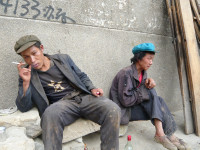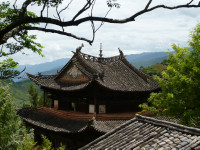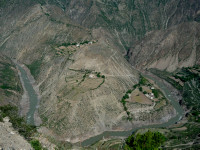







Yunnan's Northwest
to Yunnan's Southeast
to Yunnan's Southwest
to Sichuan and Qinghai: Kham
back to main Archive page
Spectacular natural scenery is the main
attraction of this part of the province. Plus there are some atmospheric
ancient villages.
Mekong in North Yunnan
South of Deqin a road now stretches roughly 500 kilometres along the
banks of the Mekong, Southeast Asia’s greatest river. It hovers high
above the river at times, making for spectacular views. The valley is
steep but nevertheless cultivated, and it is inhabited by Tibetans at
first, and further downstream by Lisu, Naxi and Bai people.
You have a choice to travel along this whole section of the river in a
number of days, or along just part of it using one of five access roads.
I will advise you on the best option for your type of tour and clients.
Weixi
Weixi is a lively county town, and an interesting mix of tradition and modernity. You find new shops and hotels alongside old wooden buildings. Some of the Lisu and Yi women still wear their traditional dress. In the morning, Lisu boys take their charcoal and other merchandise into town - they are drunk by noon. Their horses contrast sharply with the hip bright colours of the taxi’s. To the west of Weixi lies the Mekong river. To the east, roads lead to the Yangzi river and Lijiang, among other places. One of them passes through a very beautiful rural valley. Here too I will advise you on your options.
Lanping
Lanping consists of an older and newer town, a few kilometres apart. The latter is surprisingly big and modern. There isn’t that much to see. But Lanping is a convenient stop, either for lunch or to stay overnight, as roads connect it with Nuodeng to the south, the Mekong river to the west and Dali and Lijiang to the east.
Villages of Nuodeng and Shaxi
These villages are mentioned in recent guide books. But they do not explain how to easily combine a visit to the two. Visiting both makes sense, because apart from being ancient and being largely inhabited by Bai people, they are very different. Shaxi is now largely restored, and Nuodeng isn’t; Nuodeng is much older; and Shaxi lies in the middle of a wide valley surrounded by farmland whereas Nuodeng is up in the hills near the edge of a forest.
